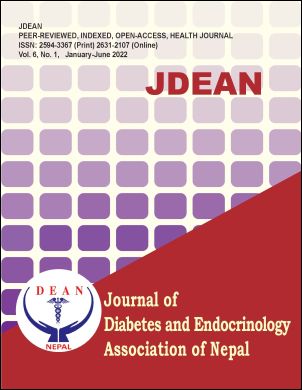Assessment of factors associated with poor glycemic control among patients with Type 2 diabetes mellitus
DOI:
https://doi.org/10.3126/jdean.v6i1.50352Keywords:
Hyperclycemia, Prediabetes, Thyroid dysfunction, ScreeningAbstract
Background: Diabetes Mellitus type 2 (DM) is a metabolic syndrome with multiple complications. All of those complications are directly related to glycemic control status.. Adequate glycemic control leads to less complications, morbidity and mortality.
Aims and objective: The aim of this study is to access the factors associated with poor glycemic control in DM subjects.
Materials and methods: This is a OPD based cross-sectional descriptive study conducted in Nobel Medical College and Teaching Hospital among adult DM subjects over the period of one year. A total of 105 cases with DM aged ≥18 years were included and clinical profile, laboratory reports were documented.
Results: We found that out of 103 population 60 people (58.2%) had poor glycemic control i.e Hba1c >7% and only 43 (41.8) had good glycemic control i.e. Hba1c <7%. FBS and PP glucose was found to be higher in poor control group compared to good control and was statistically significant (p<0.001). Smilarly duration of DM was also found to be associated with poor glycemic control.
Conclusion: FBS, PP and duration of DM was associated with higher Hba1c leading to higher prevalence of poor glycemic control. Age, sex, dyslipidemia, BMI, WHR were not found to be associated with poor glycemic control.
Downloads
Downloads
Published
How to Cite
Issue
Section
License
Copyright (c) 2022 Pratap Kumar Roy, Sanjay Kumar Jha

This work is licensed under a Creative Commons Attribution-NonCommercial 4.0 International License.
This license enables reusers to distribute, remix, adapt, and build upon the material in any medium or format for non-commercial purposes only, and only so long as attribution is given to the creator.




